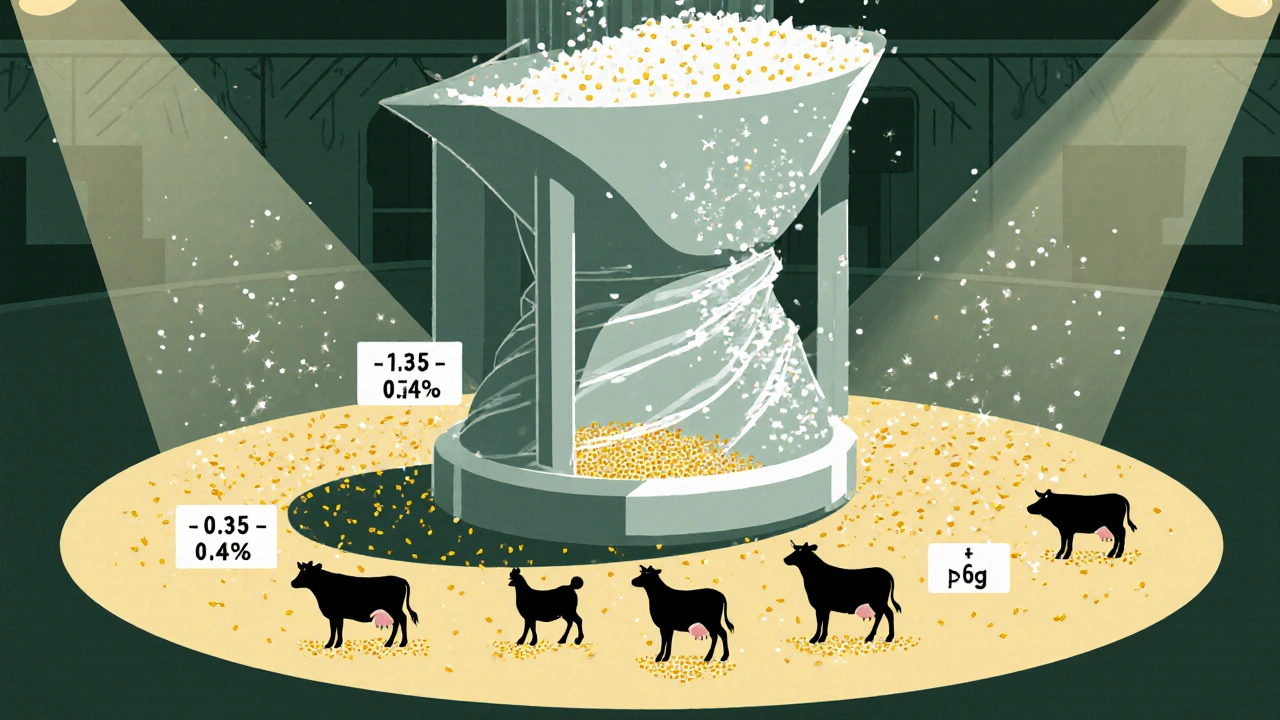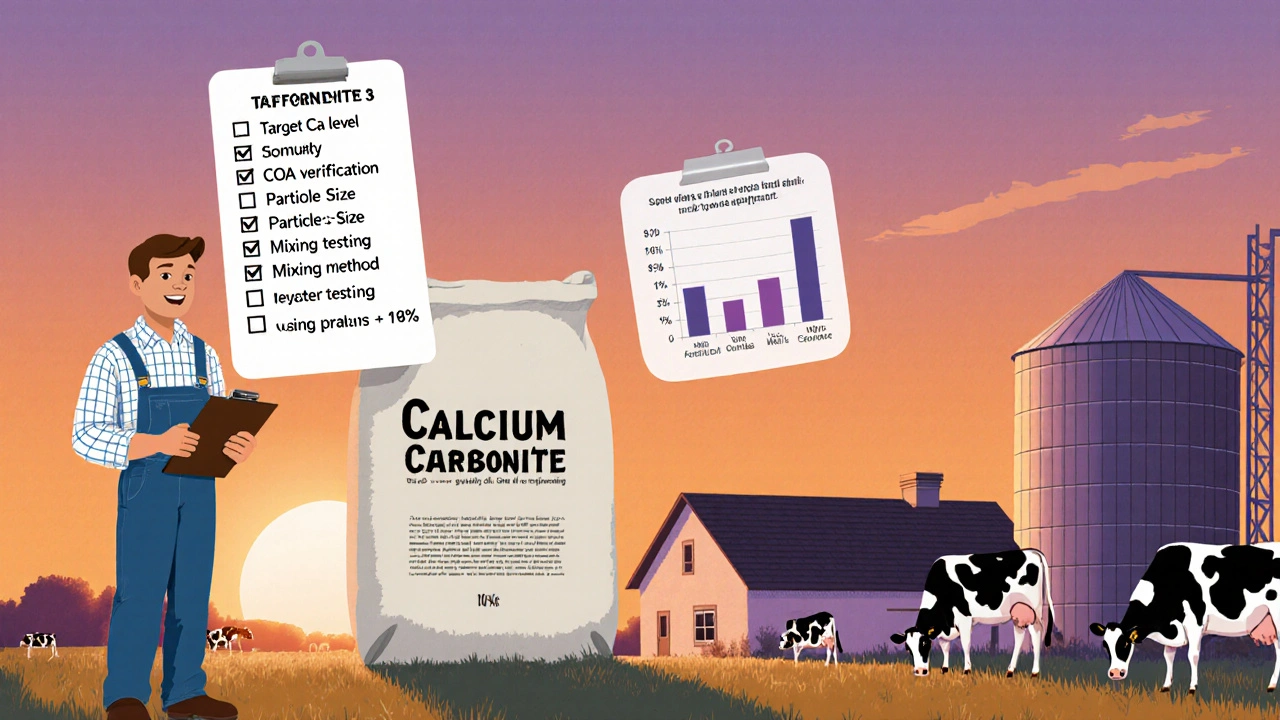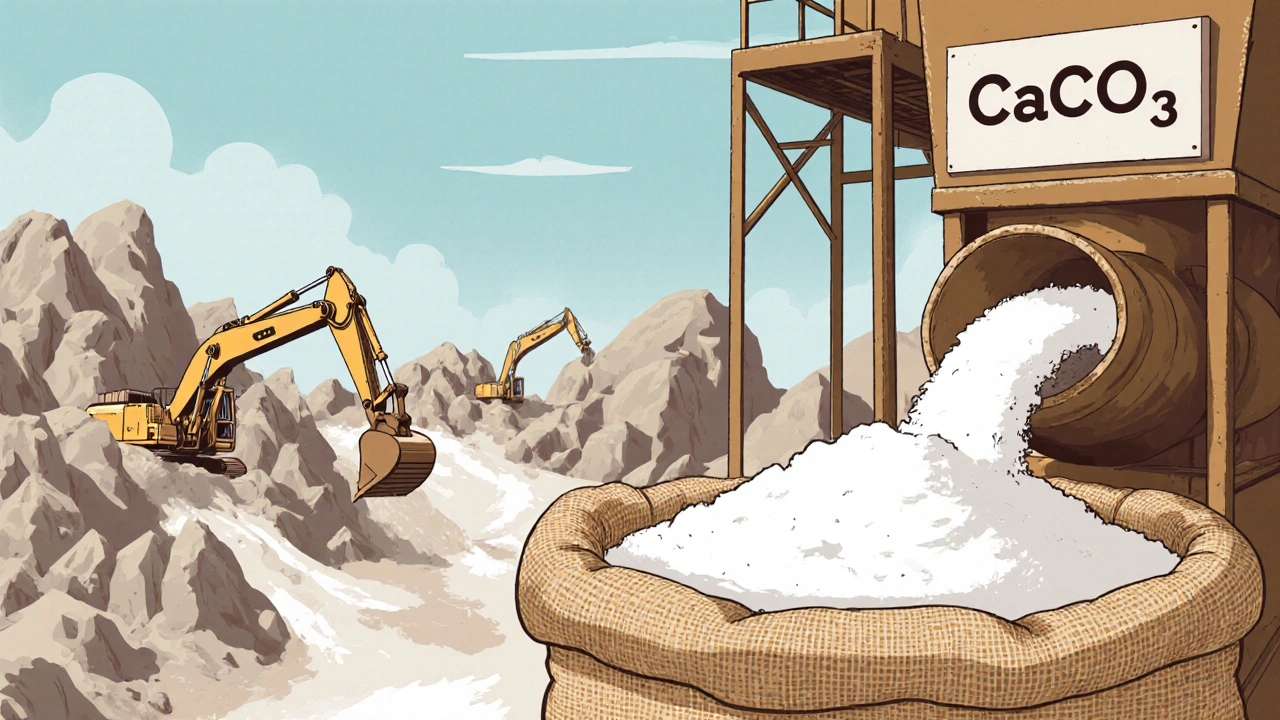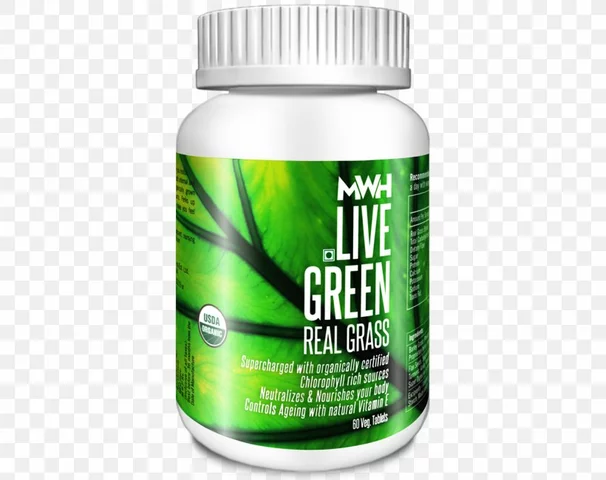Calcium Carbonate Feed Calculator
Determine Calcium Carbonate Requirements
This calculator helps determine the correct amount of calcium carbonate to add to animal feed based on species-specific guidelines.
When you hear "calcium carbonate," you probably think of chalk or antacids. In the world of animal agriculture, that same white powder is a silent workhorse that keeps herds healthy and farms profitable. Below we’ll walk through why feed manufacturers add calcium carbonate to livestock rations, how to get the dosage right, and what pitfalls to avoid.
What is calcium carbonate?
Calcium carbonate is a naturally occurring mineral, chemical formula CaCO₃, that appears as a fine white powder. It’s mined from limestone or quarried as chalk, then milled to a specific particle size for feed use. Because it’s cheap, stable, and highly bio‑available, calcium carbonate has become the go‑to calcium source for most feed mills worldwide.
Why add calcium carbonate to animal feed?
Livestock need calcium for three big reasons:
- Building strong bones and teeth.
- Supporting muscle contraction and nerve function.
- Neutralizing excess acidity in the rumen or gut.
Adding calcium carbonate hits all three without adding unwanted flavors or toxins. It also supplies a modest amount of carbonate ions that help maintain a stable pH in the digestive tract, which can improve feed efficiency.
How calcium carbonate works in Animal feed
The mineral dissolves slowly, releasing calcium ions that are readily absorbed in the small intestine. For ruminants, the carbonate component acts like a buffer, softening the acidic environment created by rapid fermentation of high‑energy diets. This buffering effect reduces the risk of sub‑acute ruminal acidosis (SARA), a common issue in high‑production dairy herds.
Species‑specific dosage guidelines
Getting the right amount is crucial-too little, and you see weak bone growth; too much, and you waste money or risk mineral imbalances. Below are practical starting points based on NRC (National Research Council) recommendations.
- Dairy cattle: 0.35-0.45% calcium in the total diet, with at least 30% coming from calcium carbonate.
- Beef cattle (growing): 0.30-0.35% total calcium, 25-30% from calcium carbonate.
- Poultry (layers): 0.90-1.00% total calcium; calcium carbonate typically supplies 70-80% of that.
- Poultry (broilers): 0.80-0.90% total calcium; aim for 60-70% from calcium carbonate.
- Swine (sows): 0.40-0.45% total calcium, 30-35% from calcium carbonate.
- Swine (grow‑finish): 0.30-0.35% total calcium, 20-25% from calcium carbonate.
Always adjust for the mineral composition of other ingredients (e.g., bone meal, dicalcium phosphate) and for regional water calcium levels.

Formulation tips for the Feed mill
Feed mill operators need to consider three technical factors:
- Particle size: Aim for 150-300 µm. Finer particles mix more evenly but can increase dust, which is a safety hazard.
- Uniform distribution: Use a high‑speed mixer or double‑pass addition to avoid ‘hot spots’ where calcium concentration spikes.
- Purity: Source calcium carbonate with ≥98% CaO. Impurities like magnesium or silica can affect the balance of other minerals.
When you run a pilot batch, test the finished feed for calcium content (ICP‑OES is ideal) to confirm that your target level was hit.
Common pitfalls and how to avoid them
Even seasoned nutritionists slip up. Here are the most frequent errors and quick fixes:
- Over‑dosing: Adding more calcium than needed can interfere with phosphorus absorption, leading to poor bone mineralization. Keep the calcium-to‑phosphorus ratio between 1.2:1 and 2.0:1 for most species.
- Ignoring source variability: Different suppliers may list calcium carbonate at 96% or 99% calcium. Always verify the certificate of analysis (COA) before you formulate.
- Dust explosions: Fine calcium carbonate dust is combustible. Ensure proper ventilation and use dust‑suppressing equipment.
- Not accounting for water mineral content: In hard‑water regions, livestock already ingest calcium from drinking water. Reduce feed calcium accordingly.
Calcium carbonate versus other calcium sources
| Source | Calcium % (CaO) | Cost (USD/kg) | Bio‑availability | Buffering effect |
|---|---|---|---|---|
| Calcium carbonate | 40-42 | 0.15 | High | Strong |
| Dicalcium phosphate | 22 | 0.30 | Medium | None |
| Calcium citrate | 21 | 0.45 | Very high | None |
| Limestone (raw) | 38-40 | 0.12 | High | Moderate |
When cost is a primary driver, calcium carbonate wins hands down. If you need a simultaneous phosphorus source, dicalcium phosphate may be more efficient.

Real‑world case study
A mid‑size dairy farm in Alberta switched from a mixed mineral premix to a formulation that relied 70% on calcium carbonate. Within six months, milk protein increased by 0.15%, somatic cell count dropped 12%, and feed cost per hundredweight of milk fell $0.03. The key was tighter control of particle size and a COA‑verified 99% purity product.
Quick checklist for adding calcium carbonate
- Confirm target calcium level based on species and production stage.
- Choose a supplier with a COA showing ≥98% CaO.
- Grind to 150-300 µm and test particle distribution.
- Mix using a high‑speed twin‑screw or double‑pass system.
- Test finished feed for total calcium and Ca:P ratio.
- Adjust for water hardness and other calcium‑rich ingredients.
Frequently Asked Questions
Can I use raw limestone instead of processed calcium carbonate?
Yes, raw limestone can work if it meets the same purity and particle‑size specs. However, raw material often contains more silica and magnesium, which may require adjustments in the rest of the mineral mix.
What’s the risk of feeding too much calcium carbonate?
Excess calcium can tie up phosphorus, leading to poor bone development and reduced growth rates. It can also cause urinary calculi in male goats and sheep. Keep the Ca:P ratio within the recommended range.
How often should I test my feed for calcium levels?
At least once per formulation change and quarterly thereafter. If you notice changes in animal performance, test immediately.
Is calcium carbonate safe for poultry hatchlings?
Yes, but keep the inclusion level low (around 0.5% of the starter diet). High levels can interfere with the absorption of other trace minerals like zinc and copper.
Does calcium carbonate improve rumen pH in dairy cows?
It provides a buffering effect, helping to keep rumen pH above the critical 5.8 threshold, especially when cows are on high‑starch diets. Pair it with a proper fiber source for best results.
Whether you’re formulating a new starter mash or tweaking an existing ration, calcium carbonate remains a reliable, cost‑effective way to meet the mineral needs of modern livestock. Follow the dosage guidelines, keep an eye on purity, and you’ll see healthier animals and a tighter bottom line.







Felix Chan
19 October 2025 - 20:30 PM
Calcium carbonate's low cost really makes a big difference in feed budgets!
ashanti barrett
25 October 2025 - 15:24 PM
I've seen farms that ignore the buffering capacity of calcium carbonate and end up with dreaded rumen acidosis spikes. Keeping the Ca:P ratio tight and monitoring water hardness can save you headaches and vet bills. The dosage ranges you listed are solid, but always start on the lower end when you switch suppliers. Also, consider testing the particle size after any re‑grind – dust can become a safety issue fast. Stick to the checklist and the herd will thank you.
jagdish soni
31 October 2025 - 09:17 AM
One must contemplate the very essence of mineral supplementation as an art rather than a mere mechanical addition the calcium carbonate, a humble limestone derivative, epitomizes this philosophical duality its crystalline lattice offers both structural fortitude and an alchemical buffering that whispers to the rumen's acidic chorus as if nature herself were drafting a silent treaty between acidity and basicity the practitioner, aware of this subtlety, ought to calibrate not only the percentage but the very particle morphology for optimal kinetic dissolution whilst ignoring the variance in supplier purity would be tantamount to a scholar dismissing primary sources outright thus, the diligent nutritionist embraces both analytical rigor and a reverence for the elemental grace embodied in calcium carbonate
Monika Bozkurt
6 November 2025 - 04:10 AM
From a metabolic standpoint, the incorporation of calcium carbonate aligns with the homeostatic regulation of electrolyte balance, particularly influencing the Ca2+/HCO3- buffering system within the rumen milieu. The NRC guidelines you referenced can be further refined by integrating plasma ionized calcium metrics, thereby enabling a dynamic feedback loop between dietary input and systemic compliance. Additionally, consideration of the limestone's silicate impurity profile is critical, as excess SiO2 may impede phosphorus bioavailability through competitive adsorption mechanisms. It is advisable to implement routine inductively coupled plasma (ICP‑OES) verification not only for total calcium but also for trace contaminants, ensuring compliance with the ≥98 % CaO purity threshold stipulated in your checklist.
Ankitpgujjar Poswal
11 November 2025 - 23:04 PM
Listen up, if you’re still guessing on particle size you’re leaving money on the table-aim for that 150‑300 µm window and run a quick sieve test before every batch. Uniform distribution isn’t optional; a single hot spot can throw off the entire herd’s performance, so double‑pass the mixer and watch those calcium readings. Adjust your formula the minute water analysis shows high hardness; over‑dosing is a rookie mistake that wrecks phosphorus absorption. Keep the Ca:P ratio tight and the profit margins tighter.
Bobby Marie
17 November 2025 - 17:57 PM
Got the chalk in the bin, but don’t forget the dust suppression fans. Too much fine powder can set off a spark in a closed mill. Keep the vent open, wear a mask, and you’ll stay safe.
Christian Georg
23 November 2025 - 12:50 PM
Great rundown! 😀 If you’re looking for a quick verification method, a handheld XRF analyzer can give you real‑time CaO percentages without sending samples to the lab. Just calibrate it with a known 99 % standard and you’ll have on‑site confidence. Also, when you’re blending, a low‑shear twin‑screw mixer reduces dust cloud formation and improves homogeneity. Remember to log each batch’s particle size distribution; over time you’ll spot trends before they become costly issues.
Christopher Burczyk
29 November 2025 - 07:44 AM
The article, while comprehensive, overlooks the economic implications of transport logistics for bulk calcium carbonate. Freight costs can significantly erode the marginal savings highlighted, especially when sourcing from distant quarries. Moreover, the recommendation to target a 30‑45 % inclusion rate fails to account for regional variations in feed ingredient calcium content, which can render the proposed percentages suboptimal. A more nuanced cost‑benefit analysis incorporating regional supply chain data would strengthen the guidance.
Nicole Boyle
5 December 2025 - 02:37 AM
Honestly, the piece nails the basics but could use a deeper dive into the interaction between limestone-derived carbonate and rumen microbiota. The buffering effect isn’t just about pH; it also shifts volatile fatty acid profiles, which in turn influences milk fat synthesis pathways. A side‑by‑side comparison of calcium carbonate vs. calcium citrate in terms of milk component yields would be a solid addition for dairy ops.
Caroline Keller
10 December 2025 - 21:30 PM
Can you even imagine the chaos when you skip the COA and end up with 96% purity? The herd goes straight to clawing at each other the milk drops the next day the vet shows up with a sigh it's a disaster purely because someone thought “it’s just chalk”.
dennis turcios
16 December 2025 - 16:24 PM
The guidelines are fine but the article feels like a rehash of old bullet points. Could use more fresh data.